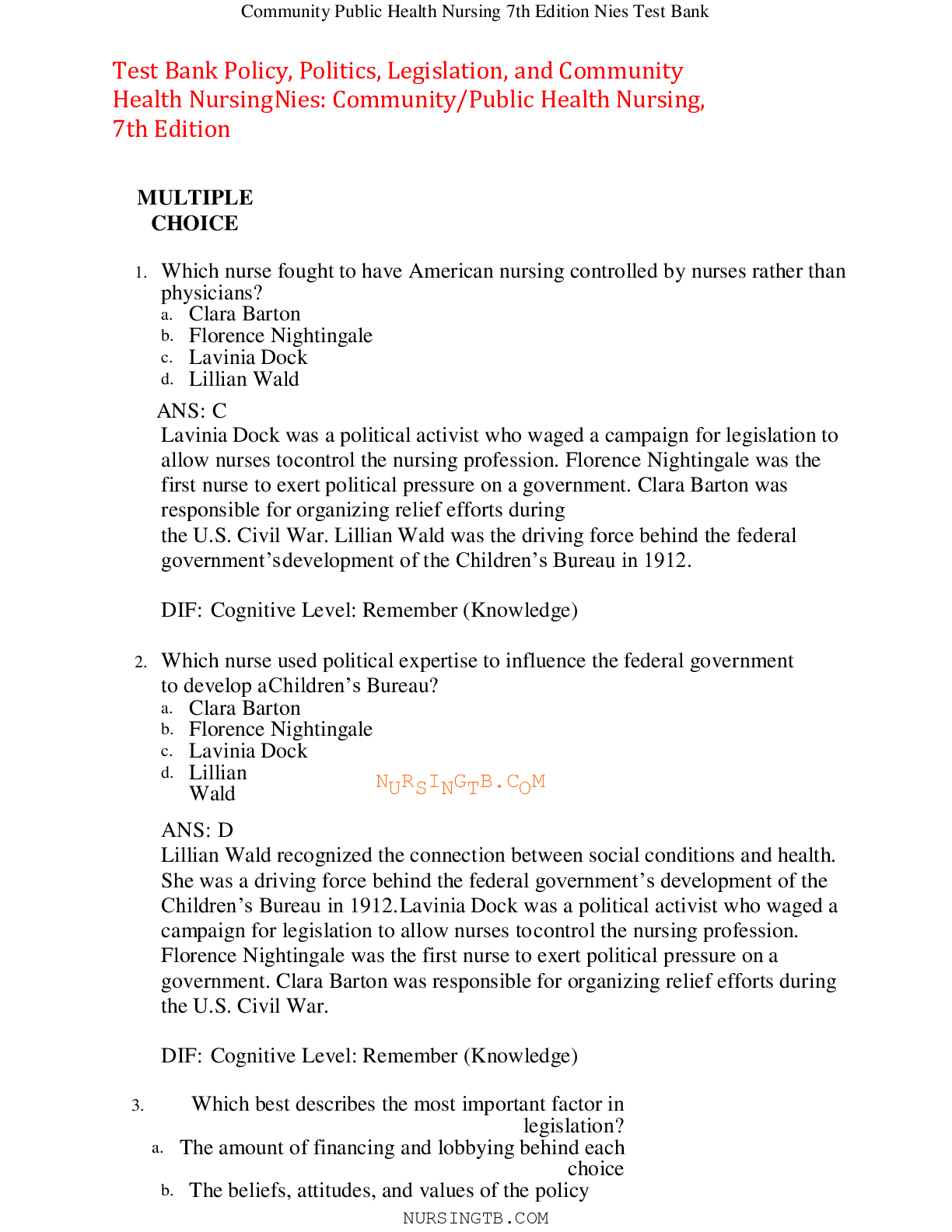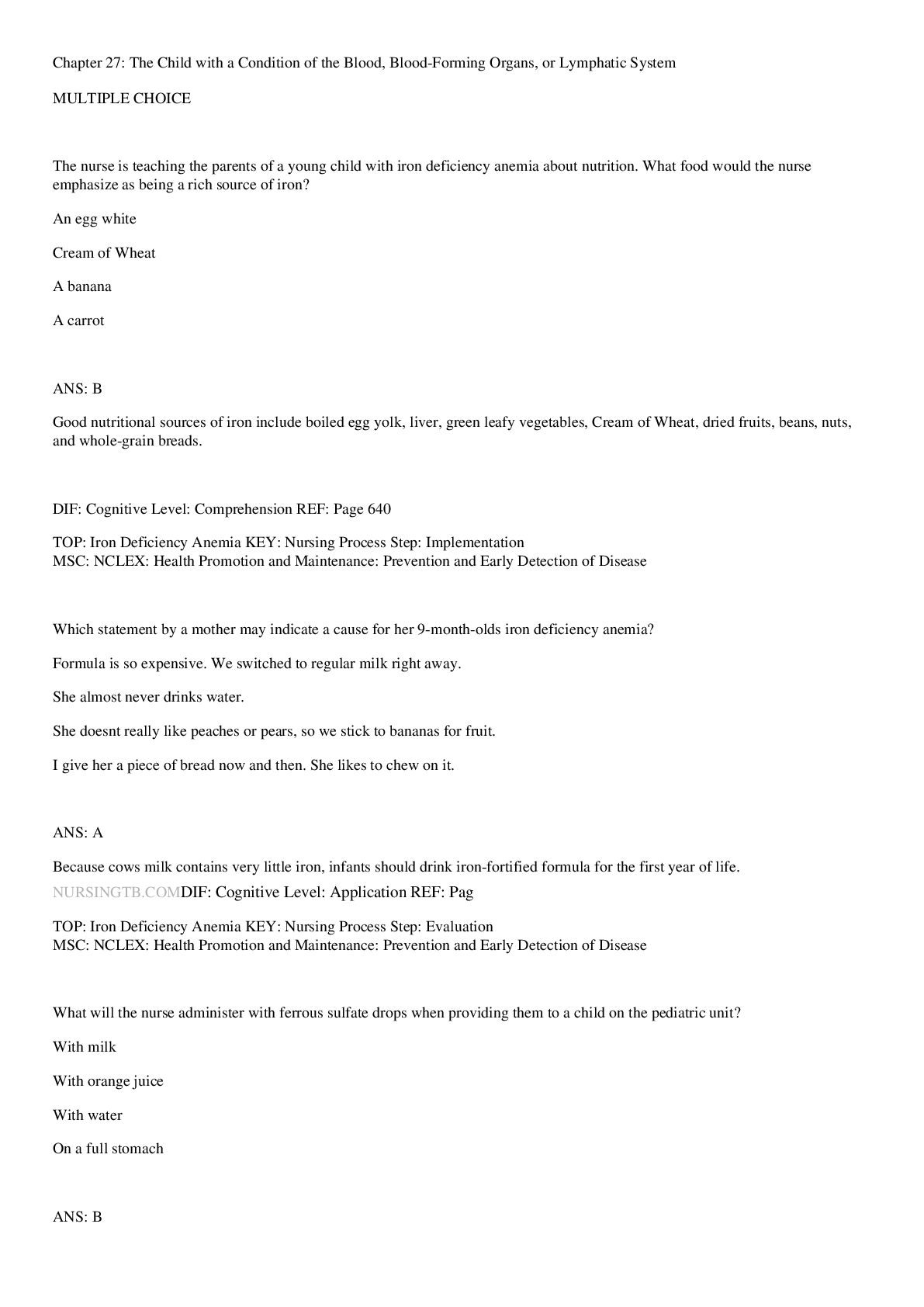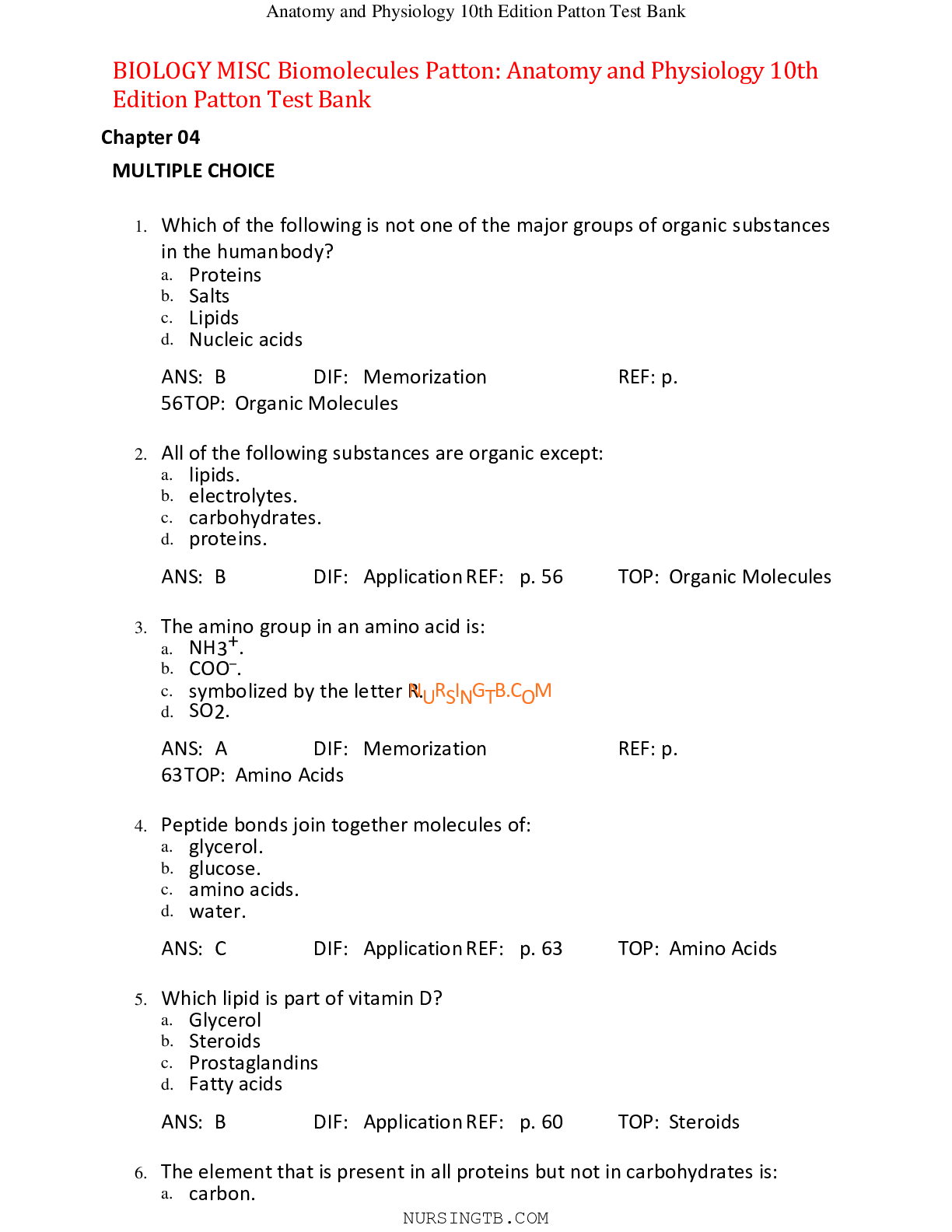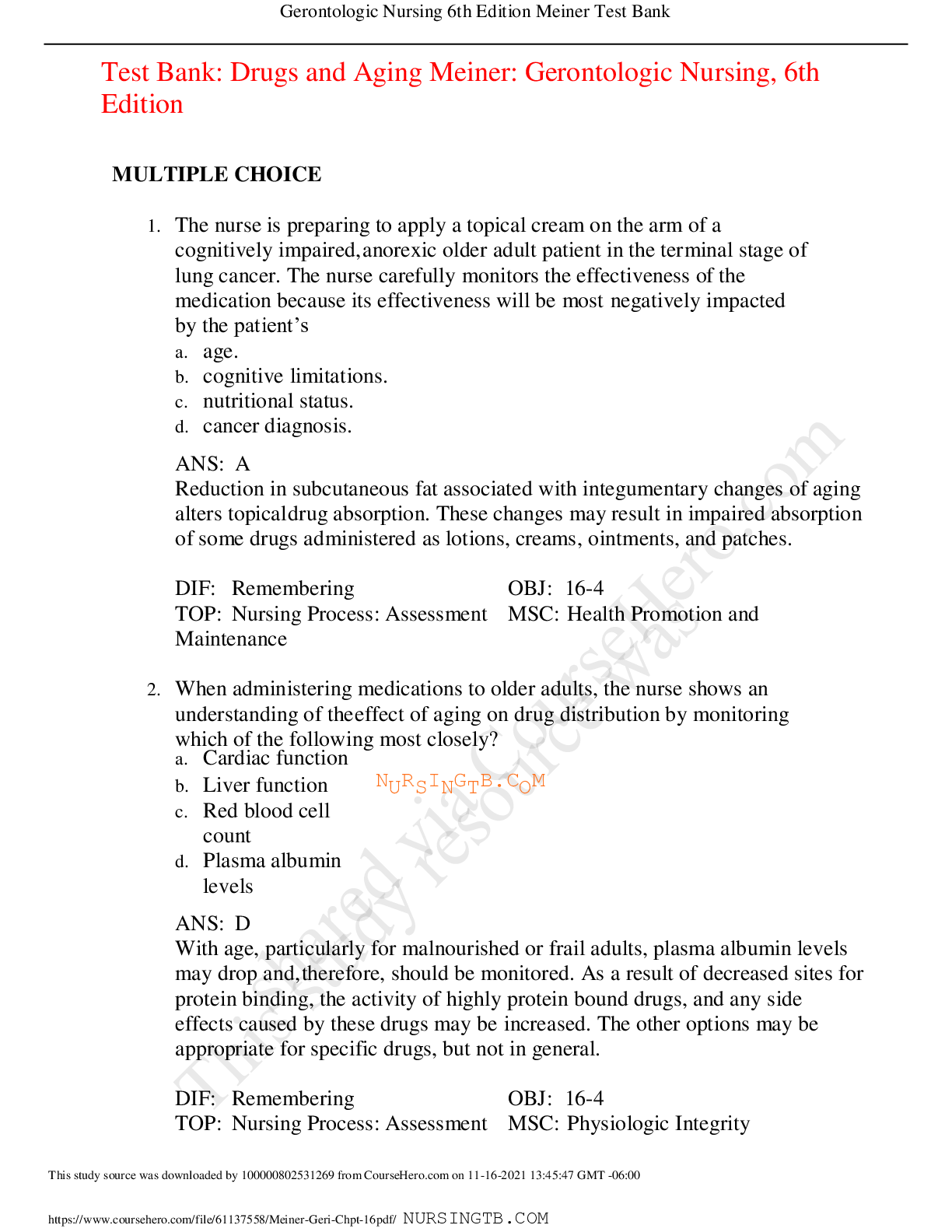*NURSING > TEST BANK > Test Bank: Cardiovascular Function Meiner: Gerontologic Nursing, 6th Edition,100% CORRECT (All)
Test Bank: Cardiovascular Function Meiner: Gerontologic Nursing, 6th Edition,100% CORRECT
Document Content and Description Below
Test Bank: Cardiovascular Function Meiner: Gerontologic Nursing, 6th Edition MULTIPLE CHOICE 1. The nurse is teaching cardiovascular risk factors to a group of older adults. The nurse stresses... that cigarette smokers are four times more likely to die of sudden cardiac death than nonsmokers. What is the reason behind this statement? a. Smoking interferes with the development of collateral coronary vessels. b. Smoking produces coronary artery stricture. c. Smoking results in carbon monoxide poisoning. d. Smoking increases platelet aggregation. ANS: D Smoking increases platelet aggregation and causes coronary artery spasms. Nicotine increases blood pressure and cardiac demands. Carbon monoxide in tobacco smoke decreases the oxygen-carrying capacity of the blood. Smoking does not interfere with collateral circulation or produce strictures, but it may contribute to higher levels of carbon monoxide in the blood. DIF: Understanding OBJ: 19-2 TOP: Integrated Process: Teaching-Learning MSC: Health Promotion and Maintenance 2. The patient is an older, female, African American adult who has a 10-year history of type 2 insulin-dependent diabetes.NTUhRe SnuIrsNeGnoTteBs.thCaOt tMhe patient’s greatest risk for developing secondary hypertension is her a. gender. b. ethnic origin. c. vascular system status. d. insulin therapy. ANS: C Secondary hypertension identified in the vascular system refers to elevated blood pressure caused by underlying disease such as renal artery disease, renal parenchymal disorders, endocrine and metabolic disorders, central nervous system (CNS) disorders, coarctation of the aorta, and increased intravascular volume. Gender, ethnic origin, and insulin therapy are not diseases that cause hypertension. DIF: Remembering OBJ: 19-2 TOP: Nursing Process: Assessment MSC: Physiologic Integrity 3. When administering metoprolol to an older adult patient with hypertension, the nurse is careful to have the patient’s care plan include a. frequent assessment for dizziness or syncope. b. education of the signs and symptoms of thromboembolism. c. regular evaluation of the patient’s muscle strength. d. regularly scheduled serum potassium levels. ANS: A Dizziness is an adverse reaction to beta-blockers such as metoprolol. DIF: Remembering OBJ: 19-5 TOP: Nursing Process: Assessment MSC: Physiologic Integrity 4. The nurse educates the obese older adult patient that the single most important outcome that will affect his or her cardiac health is a. compliance with drug therapy. b. adherence to the DASH diet. c. 20 minutes of exercise daily. d. a 10% reduction in weight. ANS: D A 10% reduction of total weight will decrease blood pressure in many overweight individuals. This factor has significance because it underscores the importance of weight reduction in the older adult population. The other factors are important but not as significant to overall cardiac health as is weight loss in this obese patient. DIF: Understanding OBJ: 19-2 TOP: Integrated Process: Teaching-Learning MSC: Health Promotion and Maintenance 5. To evaluate an older patient for possible renal failure as a result of chronic untreated hypertension, nurse prepares to a. schedule an ultrasound. b. collect a urine sample. N R I G B.C M c. monitor intake and output. d. order an abdominal x-ray. ANS: B A urinalysis will investigate for proteinuria or other signs of renal failure. The kidneys are a target organ for damage from hypertension. An ultrasound, intake and output, and abdominal x-rays are not used before a urinalysis. DIF: Remembering OBJ: 19-3 TOP: Nursing Process: Assessment MSC: Physiologic Integrity 6. A novice nurse requires additional education on arterial vascular deficiency when suggesting the condition’s symptoms include a. 2+ edema in calf and foot of left leg. b. a 2-cm ulcer between two toes on the left foot. c. skin on the left leg is cool to the touch. d. toenails on the left foot are thick and brittle. ANS: A Edema is not generally observed in cases of arterial deficiency, but rather in venous insufficiency. The other options are manifestations of arterial vascular deficiency. DIF: Remembering OBJ: 19-4 TOP: Integrated Process: Teaching-Learning MSC: Physiologic Integrity 7. The nurse shows an understanding of how anemia symptoms present in the older population when a. questioning the patient about dizziness when turning over in bed. b. assessing the patient for pale oral mucous membranes. c. asking whether the patient takes supplementary iron tablets. d. assessing the patient’s weekly intake of red meat. ANS: B Skin color is not a good indicator of pallor because of varying pigmentation. Oral mucous membranes, as well as conjunctivae and nail beds, are better indicators. The other options are not related to symptoms. DIF: Remembering OBJ: 19-5 TOP: Nursing Process: Assessment MSC: Physiologic Integrity 8. A nurse has provided discharge teaching for an older adult patient who had a pacemaker implanted. Which statement by the patient indicates appropriate understanding of the device? a. “The battery will need charging every 2 years or so.” b. “I’m supposed to call my doctor if my pulse is within 10 beats of my preset rate.” c. “My wife will have to be the one who makes the microwave popcorn.” d. “I’ll take my pulse each morning before my first cup of coffee.” ANS: D NURSINGTB.COM The radial pulse should be taken at the same time daily and recorded. The patient should notify the provider if the pulse is lower than the preset lower limit on the pacemaker. Battery life is longer than 2 years. Microwaves are safe to use. DIF: Evaluating OBJ: 19-4 TOP: Nursing Process: Evaluation MSC: Health Promotion and Maintenance 9. A 76-year-old patient has been recently diagnosed with cardiac valvular disease. The nurse assesses the patient and recognizes that the medical diagnosis is supported by which finding? a. Cyanotic fingertips b. Weight loss of 10 pounds in 3 months c. Angina pain d. Shortness of breath with activity ANS: D Individuals with valvular disease may be asymptomatic for many years, but with the deterioration of the valves and hypertrophic changes in the atria or ventricles, symptoms become evident. Exertional dyspnea is frequently the initial symptom. Other symptoms include dizziness, fatigue, weakness, and palpitations. The other signs are not manifestations of valve disease. DIF: Remembering OBJ: 19-5 TOP: Nursing Process: Assessment MSC: Physiologic Integrity 10. An older patient is upset with a blood pressure reading of 180/78 mmHg. What response by the nurse is best? a. “It looks like you need blood pressure medicine now.” b. “Most people get hypertension when they get older.” c. “Let’s plan to check it again tomorrow.” d. “Don’t worry, there are lots of good medications for this.” ANS: C With age, elastin in vessel walls decreases, making them stiffer. Systolic blood pressure (SBP) is increased in older adults because of a loss of arterial distensibility resulting from arterial stiffening. The diagnosis of hypertension is a reading over 130/80 mmHg in older people taken on three different occasions during more than two office visits. The nurse plans for the patient to return for another blood pressure reading. The patient needs a diagnosis of hypertension to begin medications. Many people do have higher blood pressures as they age, but stating this does nothing to ease the patient’s concern. Telling the patient not to worry is patronizing and dismissive. DIF: Understanding OBJ: 19-3 TOP: Integrated Process: Teaching-Learning MSC: Health Promotion and Maintenance 11. An older patient is overwhelmed at the number of lifestyle changes needed to manage newly diagnosed cardiovascular disease. What action by the nurse will reduce this barrier to teaching? a. Tell the patient even smNall RchaIngesGovBer.tiCme Mmake a big difference. b. Tell the patient that smoking is the biggest risk factor and needs to stop. c. Help the patient choose a change and incorporate it into daily life. d. Educate the patient on the consequences of not making changes. ANS: C Although it is true that small changes over time have a great impact, the nurse needs to do more by helping the patient choose a small change to implement. The nurse should help the patient work on the risk factor he or she is most willing to change. Education is important, but it will not enable the patient to make changes. DIF: Applying OBJ: 19-5 TOP: Integrated Process: Teaching-Learning MSC: Health Promotion and Maintenance 12. A nurse is caring for a patient taking furosemide. What assessment finding needs to be reported to the provider immediately? a. Weight gain of pound (1.1 kg) in 24 hours b. 2+/4+ pedal and pretibial edema c. Potassium level: 2.6 mEq/L d. Sodium level: 138 mEq/L ANS: C Furosemide is a potassium-wasting diuretic and the patient’s potassium is critically low. This finding should be reported. The weight gain should be charted but does not need immediate reporting. Without knowing what the patient’s baseline edema is, there is no indication this needs to be reported. The sodium level is normal. DIF: Applying OBJ: 19-5 TOP: Integrated Process: Communication and Documentation MSC: Physiologic Integrity 13. An older patient is prescribed nifedipine for hypertension. What teaching topic is most important to discuss with this patient? a. Need to monitor blood pressure b. Need to follow low-salt diet c. Need to change positions slowly d. Need to add exercise to daily routine ANS: C Calcium channel blockers such as nifedipine can cause orthostatic hypotension and dizziness in older adults. The nurse educates the patient on preventing this by slow position changes. The other topics are appropriate for all patients on medication for hypertension. DIF: Applying OBJ: 19-4 TOP: Integrated Process: Teaching-Learning MSC: Physiologic Integrity 14. A patient had a heart attack and the nurse identifies the diagnosis as activity intolerance. What assessment finding indicates a priority goal for this diagnosis is being met? a. Mild chest pain gettingNintoRtheIchGair B.C M b. Feels unsteady when getting out of bed c. O2 saturation 98% after using the commode d. Less dyspnea when changing positions ANS: C Activity intolerance is measured by changes in vital signs, electrocardiogram (ECG), and symptoms such as chest pain or shortness of breath. The oxygen saturation indicates physiologic tolerance to activity. The other options do not show physiologic tolerance. DIF: Analyzing OBJ: 19-5 TOP: Nursing Process: Evaluation MSC: Physiologic Integrity 15. An older patient in the internal medicine clinic reports usually being able to walk 1 mile without complaint. However, in the past 2 weeks, after walking just mile, the patient’s legs begin to ache. The pain goes away with rest. What action by the nurse is most appropriate? a. Elevate the patient’s legs. b. Assess the pedal pulses. c. Take the patient’s blood pressure. d. Measure the patient for TED hose. ANS: B This patient has intermittent claudication, a sign of peripheral arterial disease. The nurse assesses the patient’s pedal pulses. Elevation will further compromise circulation and should be avoided. A blood pressure reading is taken during all health care visits. The patient does not need TED hose for an arterial problem. DIF: Applying OBJ: 19-5 TOP: Nursing Process: Assessment MSC: Physiologic Integrity 16. A patient has peripheral vascular disease. What statement by the patient indicates a need for further teaching? a. “I will have the podiatrist cut my toenails.” b. “I will be sure to wear sturdy shoes.” c. “I can only walk limited distances now.” d. “I will report any injury to my foot or leg.” ANS: C Patients with venous insufficiency are encouraged to begin a graduated exercise program. The other statements show good understanding. DIF: Evaluating OBJ: 19-5 TOP: Nursing Process: Evaluation MSC: Physiologic Integrity MULTIPLE RESPONSE 1. The effect of aging on the cardiovascular system is evidenced by which symptoms in an older adult performing a strNessRtestI? (SGelecBt .alCl thaMt apply.) a. Chest pain during exercisUe S N T O b. Slow increase of heart rate in response to stress c. Exercise induce dyspnea d. Slow decrease of heart rate post exercise e. Stress-induced arrhythmias ANS: B, D During stress or stimulation, the heart rate increases more slowly; however, once elevated, it takes longer to return to the resting rate. The other manifestations are not related to age-induced physiologic changes. DIF: Remembering OBJ: 19-1 TOP: Nursing Process: Assessment MSC: Physiologic Integrity 2. A novice nurse learns that normal aging can result in changes in the ECG of a 73-year-old patient. The experienced geriatric nurse explains that these changes may include which of the following? (Select all that apply.) a. An inverted T wave b. A notched P wave c. A prolonged PR interval d. Decreased amplitude of the QRS complex e. A slurred T wave ANS: B, C, D, E The number of pacemaker cells located in the sinoatrial node decreases with age, which results in less responsiveness of the cells to adrenergic stimulation. Common aging changes that are reflected by the electrocardiogram (ECG) include a notched P wave, a prolonged PR interval, decreased amplitude of the QRS complex, and a notched or slurred T wave. DIF: Remembering OBJ: 19-1 TOP: Integrated Process: Teaching-Learning MSC: Health Promotion and Maintenance 3. An older adult recovering from a myocardial infarction (MI) has been taking subcutaneous heparin but is now to receive oral warfarin. The nurse prepares to teach the patient which topics? (Select all that apply.) a. Administration of both medications for up to 5 days b. Need to use a soft bristle toothbrush c. Use of atropine as an antidote for excessive bleeding d. Need to continue drawing partial thromboplastin times e. Need to drink at least eight cups of fluids daily ANS: A, B, D Heparin and warfarin are anticoagulants used to prevent the enlargement of existing thrombi and new clot formation after an MI. Therapeutic effects of heparin are monitored by partial thromboplastin times; the antidote is protamine sulfate. Warfarin is monitored by the international normalized ratio (INR); the antidote is vitamin K. Patients who initially receive heparin for anticoagulation and who need oral anticoagulation for maintenance usually take both forms of medication for 3 to 5 days to develop therapeutic blood levels. Bleeding is a complication. Patients need to be taught bleeding precautions. All people should drink at least 8 cups of water a day NunUleRsSs aInNotGheTr Bm.edCicOaMl condition prohibits this. DIF: Understanding OBJ: 19-3 TOP: Integrated Process: Teaching-Learning MSC: Physiologic Integrity 4. A 77-year-old patient is being treated for cardiac arrhythmia. The nurse determines that the patient’s cardiac output is adequate with which assessments? (Select all that apply.) a. Urine output of 140 cc over 4 hours b. Systolic blood pressure that remains within 20 mm of baseline c. Denial of substernal pain d. Recollection of the birthdays of all of her grandchildren e. Absence of rales and crackles ANS: A, B, D, E The patient will maintain an adequate cardiac output, as evidenced by heart rate and rhythm within normal range, stable blood pressure, adequate peripheral pulses, mental alertness, urine output of 30 mL/hr, and clear breath sounds. Normal mentation also denotes good cardiac output, but the patient may have too many birthdays to remember, so this is not the best indicator of cognitive status. Denial of pain does not necessarily denote good cardiac output. DIF: Remembering OBJ: 19-3 TOP: Nursing Process: Assessment MSC: Physiologic Integrity [Show More]
Last updated: 1 year ago
Preview 1 out of 14 pages
Instant download

Buy this document to get the full access instantly
Instant Download Access after purchase
Add to cartInstant download
Reviews( 0 )
Document information
Connected school, study & course
About the document
Uploaded On
Nov 21, 2021
Number of pages
14
Written in
Additional information
This document has been written for:
Uploaded
Nov 21, 2021
Downloads
0
Views
31























